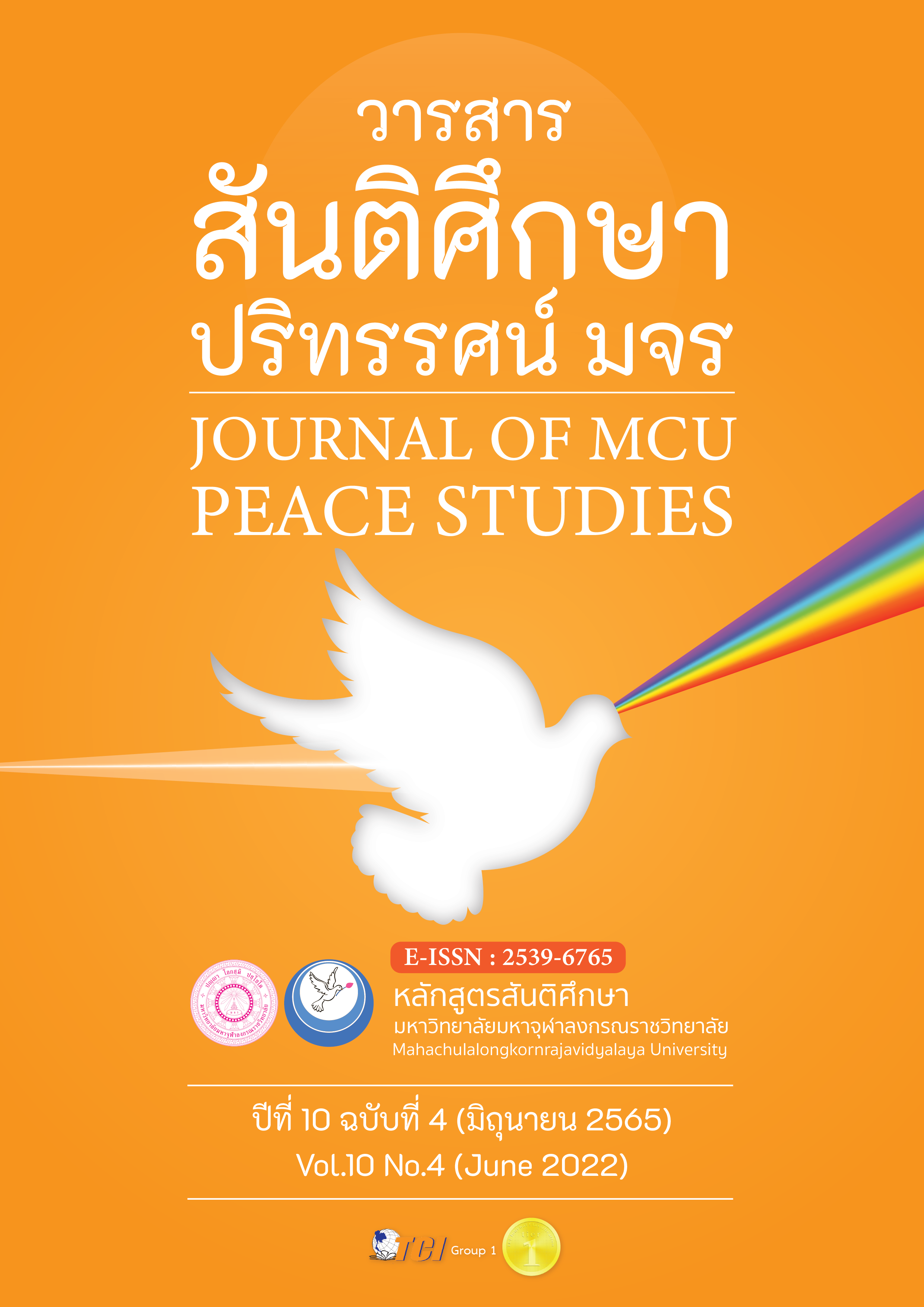Indianization and Buddhism Evolution: Influence In Ancient Southeast Asia and Lanka
Main Article Content
บทคัดย่อ
The academic article aims to illustrated features coherent between Indianization and sociology of Buddhists in previous Southeast Asia and Lanka. The study found in terms of Buddhist sociological main characteristics have the influenced from Indianization classified into five dimensions as followed 1) Indianized faith and beliefs like Brahmanism and Buddhism 2) Indianized languages and literature along with Sanskrit and Ramayana 3) Indianized kingship and administrative institutions 4) Indianized art and architecture found out through constructing designs and 5) Indianized manners of social production along with caste system that disparts rites of folk and norm.
The current article is hopefully useful for diverse future research for applying with academic particular relative to Buddhist study, history, and Indianized study, Civilization of human and especially in Southeast Asia study.
Article Details

อนุญาตภายใต้เงื่อนไข Creative Commons Attribution-NonCommercial-NoDerivatives 4.0 International License.
ทัศนะและความคิดเห็นที่ปรากฏในบทความในวารสาร ถือเป็นความรับผิดชอบของผู้เขียนบทความนั้น และไม่ถือเป็นทัศนะและความรับผิดชอบของกองบรรณาธิการ ยินยอมว่าบทความเป็นลิขสิทธิ์ของวารสาร
เอกสารอ้างอิง
Andaya, B. W. (2021). Religion and Commerce in Southeast Asia. United Kingdom: Oxford Research Encyclopedia of Asian History. https://oxfordre.com › acrefore-9780190277727-e-545
Ashta, A. (2021). Postulation of India-Japan Vedic-Buddhist cross-cultural management cluster: conceptualizing a spiritual philosophy-based explanation for emerging theory. Management Research Review. https://www.doi.org/10.1108/MRR-06-2020-0345.
Bapat, P.V., (ed.), (1956). 2500 Years of Buddhism. Delhi: Ministry of Information and Broadcasting, Delhi, India.
Bhandari, S. R. (2021). The Dimensions of Language and Thought in the Vedic Literature. Theory and Practice in Language Studies, 11(2), 135-144.
Burling, & Robbins. (1965). Hill Farms and Padi Fields: Life in Mainlad Southeast Asia. Englewood Cliffs. N.J. Prentice-Hall.
Codes. (1930). Bulletin. The Malay inscriptions of Srivijaya. Article: Ecole Francaise de I’Extreme Orient.
Coedes, G. (1968). The Indianized States of Southeast Asia, East-West Center. Honolulu: Hawaii: University of Hawaii. U.S.A.
Coedès, G. and Walter F., & Vella. (1968). The Indianized States of Southeast Asia. Brown S., ed Cowing. trans. Hawaii: University of Hawaii. U.S.A.
David, K. (2003). Thailand: A short history. (2nd ed.). Bangkok: Silkworm Books.
Department of Fine Arts. (2014). King Ram Khamhaeng and the Lankavong Buddhism.: Bangkok: Silpakon Journal. Silpakon University. Thailand.
Fau, N., Sirivanh, K., & Christian, T., (2013). Transnational Dynamics in Southeast Asia: The Greater Mekong Subregion and Malacca Straits Economic Corridors. Bangkok: Institute of Southeast Asian Studies.
Htin, A.U. (1976). Prawattisāt Phamā. Press: Sangkhommasat lae Manutsayasat Samakhom Sangkhommast Haeng Prathet Thai-1976. University of Michigan. Activate: 9 November 2006. p. 68-69. PDF. Accessed: 17 September 2018.
Khruarat, T., & Mukdamanee, V. (2021). Creative painting Project from Dvaravati art style. (Doctoral dissertation). Silpakorn University. Thailand.
Kumar, S., & Choudhury, S. (2021). Ancient Vedic Literature and Human Rights: Resonances and Dissonances. Cogent Social Sciences, 7(1), 1858562.
Le Manh That (1999), Lich Su Phat Giao Viet Nam (History of Vietnamese Buddhism), 1(1), Hue: Thuan Hoa
Le May, R., & Le May, R. S. (1938). A concise history of Buddhist art in Siam. CUP Archive.
Ling, T.O. (1969). Buddhist factors in population growth and control: A survey based on Thailand and Ceylon. Population Studies, 23(1), 53-60.
Majumdar, R.C. (1953). “The Indo-Siam Culture (India and Thailand) Quarterley”. 2(1), 103-121.
Majumdar, R.C. (2003). Ancient Indian colonization in South-east Asia. Delhi: Motilal Banarsidass: Publishers Private Limited.
Nguyen, T.T. & Hoang, T.T. (2008). The History of Buddhism in Vietnam. Institute of Philosophy, Vietnamese Academy of Social Sciences, Washington, D.C.: The Council for Research in Values and Philosophy, Cardinal Station, USA.
Schafer, R. (2018). Ethnography of Ancient India. Wiesbaden. Otto Uarrassowitz. 1954. E-Book.
Sharma, V., & Kant, S. (2021). Reflection of Buddhism on The Constitution of India. Bodhi Path, 20(1), 10-16.
Shukla, S. (2021). Urdu poetry: A romance between the eternal and ephemeral. The Humanistic Psychologist. https://www.doi.org/10.1037/hum0000230.
Singh, J. (2002). An Introduction to Madhyamika Philosophy. (2nd ed.). Delhi: Motilal Banarsidass Pub.
Stanlaw, J. (2002). Ancient China and Its Enemies: The Rise of Nomadic Power in East Asian History. History Reviews of New Books 31(1):43-43. January 2002.
Thich, M.T. (2009). A Brief History of Vietnamese Buddhism, Reprint. Saigon: Minh Duc, the Journal of Global Buddhism Reserch Article, 10(1). 423-458.
Thakur, U. (1986). Some Aspects of Asian History and Culture. (1st ed.). New Delhi: Shakti Malik Abhinav Publication.. Hauz Khas. 1986.
Van, V. H. (2020). The Foundation of Vietnam and India Relation. Historical Values. Asian Social Science, 16(1), 1-11.
Walpola, R. (1978). Cite in. KH Potter - Journal of Indian Philosophy. Springer.
Warner, D. X., & Owen, S. (2009). The Making of Early Chinese Classical Poetry The Late Tang: Chinese Poetry of the Mid-Ninth Century (827-860). The Journal of Asian Studies, 68(4), 1262.
Wilder, W. (2021). Communication, social structure and development in rural Malaysia: A study of Kampung Kuala Bera. Routledge.
Wilfred, F. (2021). Religious Identities: From the Colonial to the Global. Religious Identities and the Global South. Cham: Palgrave Macmillan, (pp. 41-63).
Wisetchat, S. (2013). Visualizing the Evolution of the Sukhothai Buddha. Southeast Asian Studies, 2(3), 559-582.
Zou, D. V., & Kumar, M. S. (2011). Mapping a colonial borderland: Objectifying the geo-body of India's Northeast. The Journal of Asian Studies, 141-170.


